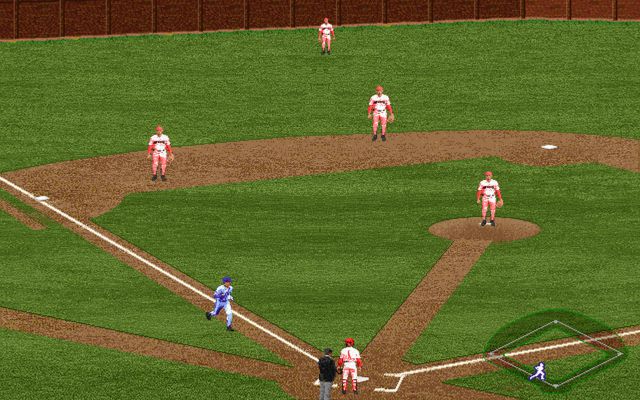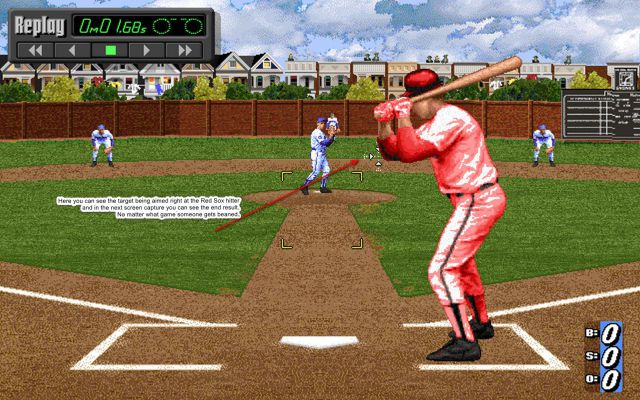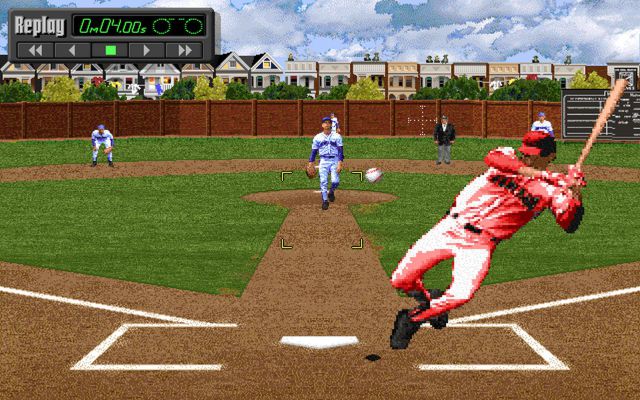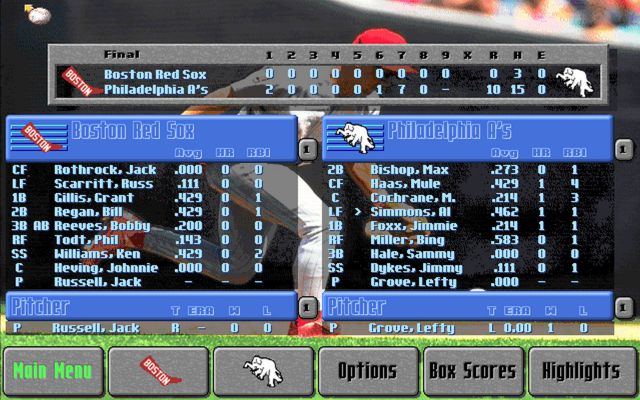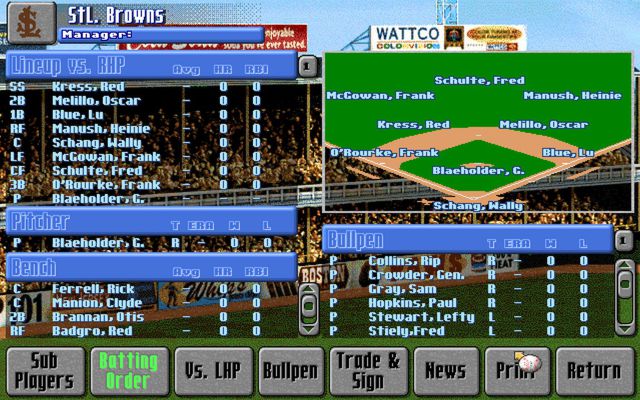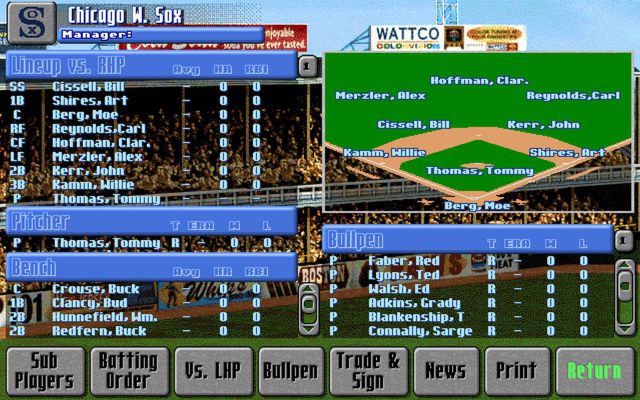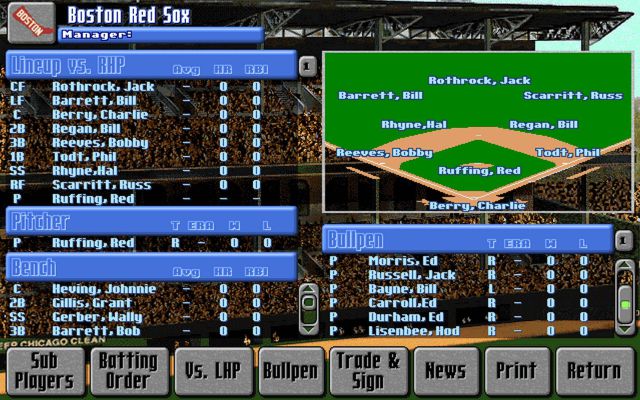-
Posts
26955 -
Joined
-
Days Won
82
Content Type
Profiles
Forums
Downloads
Everything posted by Yankee4Life
-
8 out of 10, 105 seconds. I didn't think I was that slow today but two questions really made me stop and think.
-
3 out of 10, 125 seconds. I did better than expected.
-
Ken Williams When a ballplayer leads the league in multiple offensive categories for only one season, it may be said that he had a “career year.” This term may take on even more significance if the player never comes close to duplicating the statistics he put up in his magical season. One might suggest that Ken Williams of the St. Louis Browns enjoyed such a year in 1922. The Browns had an explosive team that season, and Williams was their power hitter and an RBI machine. He led the American League in home runs (39) and RBIs (155). The St. Louis left fielder was the first player in the major leagues to hit more than 30 home runs and steal 30 bases (37). He also became the first player to hit more home runs in a season (37) than he had strikeouts (31). Williams hit a homer in six consecutive games from July 28 through August 2. On August 7 he became the first American Leaguer to hit two home runs in one inning. On a team that was known for annually finishing in the basement of the American League, the 1922 St. Louis Browns fielded an offensive juggernaut. Williams was a big part of it and helped keep the Browns in the pennant race all season. He became the first batter in the American League to hit three home runs in one game. He achieved that feat against the Chicago White Sox on April 22, 1922, at Sportsman’s Park. The onslaught propelled Williams to slug seven homers in nine games between April 22 and 29. Kenneth Roy Williams was born on June 28, 1890, in Grants Pass, Oregon, to Britton and Carrie Williams. Britton worked as a real-estate agent. Williams did not attend school after the eighth grade, but worked in a box factory. He found time to play semipro ball around the state, showing enough promise that he signed a contract with Regina of the Western Canada League. Although he was a natural right-hander, Williams batted from the left side of the batter’s box. He showed his versatility, playing every position on the diamond, except catcher. A lean, gangly fellow at 6 feet tall, Williams looked out of place on a baseball field. “I’ll never forget the first time I saw Kenny Williams in a ballgame,” remembered Portland Beavers manager Walter McCreedie. “It was on the Portland field in 1912. The Oakland Oaks had an outfielder on the sick list, and somebody suggested they send to Grants Pass to get Williams to fill in. What a big, gawky, overgrown kid he was! He didn’t even know how to wear a baseball uniform and he had a home-made pair of baseball shoes through which he had driven spikes. He was the funniest looking ballplayer I ever saw. But none of us laughed at him the first time he went to bat. All he did was to bust four balls on the nose in as many successive times at bat, every one of them a screeching line drive.” McCreedie was not the only one to take notice of the youngster’s batting prowess. After hitting .340 through the first 79 games for Spokane of the Northwest League in 1915, he was picked up by the Cincinnati Reds. It was noted of Williams that he “is showing lots of speed for a big fellow … and is some hitter.” He also demonstrated a fine ability to lay down a bunt. He started 60 games in the outfield for the Reds, mostly in left field. He hit .242 for the year. But Williams’s bright outlook was curtailed when his hitting went south and Reds manager Charley Herzog took issue with his fielding ability. The Reds also needed to get down to the 21-player limit by May 1, which made Williams expendable. Cincinnati had an optional agreement with Spokane, so he was returned to the minor-league club. Ken returned to Spokane, but he was then purchased by Portland of the Pacific Coast League. He split the 1916 season between Spokane and Portland. He was with Portland again the following year, hitting a robust .313, which led the team, and he smacked an astounding 24 round-trippers. Against Vernon on June 3, Williams hit three homers, and also added a double to his day’s work at the plate. The Browns’ business manager (general manager in today’s parlance), Bob Quinn, was a shrewd judge of talent. He signed Williams for the 1918 season, but like many players, Williams was called to active duty for the World War, and he missed much of the season. By the time Williams found his way into the everyday lineup for the 1920 season, quite a team was being but together in the Gateway City. Starting with George Sisler at first base, the team was loaded with offensive firepower. Williams’s outfield mates, Baby Doll Jacobson in center field and Jack Tobin in right, were superior batsmen. Hank Severeid was a gifted receiver behind the plate. Urban Shocker led the mound corps. The Browns finished a distant 21½ games behind pennant winner Cleveland in 1920. Yet their record of 76-77-1 placed them fourth in the standings. It was the first time the Browns found themselves in the first division since 1908. Williams batted .307 with 10 home runs and 72 RBIs. Lee Fohl took the reins of the Browns in 1921, replacing Jimmy Burke. He had managed the Indians a decade before with limited success. Fohl was considered a good manager who knew baseball but might have been a little slow on the trigger. He had almost no rapport with the players. He led the Browns to a third-place finish, and the team appeared to be on the verge of competing for the pennant the following year. Fohl and Quinn both thought that some tinkering might be needed, but nothing major in the way of personnel changes. After the 1921 World Series, won by the New York Giants over the Yankees, Bob Meusel and Babe Ruth took part in a barnstorming tour. This was a common practice among players of the day to earn some extra money during the offseason. However, the National Commission, which was then the governing body of baseball, forbade members of the teams that played in the World Series to barnstorm. Commissioner Kenesaw M. Landis fined Meusel and Ruth $3,362 apiece, which equaled the players’ shares from the World Series. In addition, each player was suspended for the first six weeks of the 1922 season. It is important to note that Ruth was idle until May 20. In that period, Williams knocked 11 home runs out of ballparks across the American League. He ended with 39 home runs to Ruth’s 35. Williams also drove in more runs than Babe, 155 to 99. He had 179 more at-bats than Ruth. Comparisons between the two players began to appear from writers’ pens in national magazines. But Williams refused to buy into the debate. “I have never made any claim that I could equal Babe Ruth as a home-run hitter,” he said. “On the other hand, I know I am not his equal. No player in the game could hope to match Ruth over a full season’s course. I have done my best. But I have never had in mind trying to beat Babe for I know it can’t be done.” Williams attributed his success at the plate to the growing confidence he had in his ability. He used a 48-ounce bat, saying, “… I always favor a heavy one because when you connect with the ball with every ounce of strength in your frame, the weight of the bat is going to help the ball to travel. That’s my theory anyway and it seems to work.” On July 23 the Yankees acquired third baseman Joe Dugan from the Boston Red Sox. Much to the dismay of owners and managers around the league, the addition of Dugan was a boon for the Yankees. After the trade, they faced off against the Browns in a four-game series. After Urban Shocker won the first game 8-0 on a six-hitter, the Yankees won the next three to leave St. Louis with a half-game lead. Dugan collected five hits and walked twice, and the value of his addition to the Yankees lineup was immediately evident. The Browns, although compiling a 93-61 record on the year, finished in second place to the Yankees by 1½ games. They dominated all their opponents except the Yankees; they were 8-14 against New York. Although the Browns won the American League pennant in 1944, it was during the war years and many of the first-line players around baseball were serving in World War II. The 1922 edition was generally thought of as the greatest Browns team of all time. Sisler hit an astounding .420, leading the league in triples (18), hits (246), and runs (134). Shocker led the league with 149 strikeouts. Williams’s power came in spurts during the season. He hit a homer in six consecutive games between July 28 and August 2, and also smacked five homers between September 4 and September 9. The heart and soul of the Browns, George Sisler, was sidelined for the entire 1923 season. He was diagnosed with sinusitis. His optic nerves became infected, and at times he would see double. Williams summed up his own thoughts, as well of those of all Browns fans, by saying, “If Sisler can’t play, we’re ruined. We can fill any other gaps that exist, but there/s no other Sisler.” Although Williams’s power numbers dipped a bit in 1923, he still managed to knock out 29 homers and drive in 91 runs. He set career highs in batting average (.357), doubles (37), and hits (198). Despite Williams’s best efforts to pick up the slack, the Browns finished in the middle of the pack in the league. Ken Williams suffered a season-ending injury on August 14, 1925. The slugger stepped in against Cleveland pitcher By Speece in the eighth inning. Speece had thrown three wide ones to Williams, but the fourth offering from the right-hander smashed into Williams’s head, just behind his right ear. He was knocked unconscious, but quickly regained his senses. Williams decided to take a shower and make his way back to the team hotel. At that instant, Indians second baseman Chick Fewster wandered into the clubhouse to check on Williams. Fewster had suffered the same type of injury, and almost lost his life. He warned Williams to bypass the shower. Ken heeded the advice. X-rays revealed a concussion. Williams read later in the year about a player in the minor leagues who suffered a similar injury, took a cold shower, and died, possibly of shock. Williams spent ten days in the hospital before returning to Oregon to recuperate. The Browns finished in third place in 1925. Browns fans were left to wonder what might have been if Williams had stayed healthy for the whole season. Bob Quinn and some partners purchased the Boston Red Sox for $125,000 in 1923. The Red Sox were wallowing in the depths of the American League, finishing in either seventh or eighth place every season since 1922. Figuring that he would need an infusion of leadership, and some talent, Quinn dealt for both Williams and Browns shortstop Wally Gerber before the 1928 season. “These two timers seem to play the game for the pure joy of it,” wrote one scribe. “They show more spirit than the players half their age. I imagine some day we will have to carry them off the field.” The statement was indeed prophetic. On August 8, 1929, Gerber, playing second base, went back on a ball as Williams came charging in for it from center field. Neither heard the other calling for the catch. They collided, each cracking their skulls. Both players were carried from the field, effectively ending their major-league careers. Williams compiled a .319 batting average for his career, stroked 196 home runs, and drove in 916 runs. He also smacked 285 doubles over his 14-year career. Though his major-league career was over, Williams returned to the Pacific Coast League in 1930, with the Portland Beavers, batting .350 with 14 home runs in 148 games. He appeared in only 20 games the following season before retiring from baseball for good. He retired to his hometown, Grants Pass, Oregon. Williams worked as a policeman and owned the Owl Billiard Parlor in Grants Pass. He died on January 22, 1959, as the result of a heart condition that he had suffered from for many years. Ken Williams indeed lived in anonymity when compared to Babe Ruth, or even with some of his teammates on the Browns. The baseball correspondent who covered the St. Louis clubs for The Sporting News illustrated the point with the following anecdote: “A photographer was told to go out and get a picture of Ken Williams swinging at the plate – and the well meaning camera artist proceeded to shoot Bill Jacobson. … Imagine the text and illustration that would have been incident to Babe Ruth hitting three home runs in one ball game! Sporting editors would have wired every syndicate in operation to rush story and photographs. But Ken hits three of them and a photographer on the ground doesn’t even know which is Ken or Bill Jacobson. …”
-
It will be tomorrow. 👍
-
I needed this Jim because the rest of the week won't be as easy. Friday, yes.
-
10 out of 10, 45 seconds. Surprisingly easy today. Who won the 1980 World Series? What teams played in the 1975 World Series? Now you know why I got all ten right.
-
Watch out for Muller. We have two weeks left and four days of those general questions and he is still in striking distance.
-
Sad to say only one Red Sox batter was hit. That I am very happy to say is my signature move in any baseball video game I have ever played. Crosshairs were enabled for both teams. I did not change pitchers because I was playing as Philadelpia.
-
10 out of 10, 34 seconds. I needed this little nest egg because this week may be tough on me with the general questions.
-
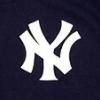
Building the "perfect" baseball game, a thread
Yankee4Life replied to Kccitystar's topic in The Bleachers
I like all of those suggestions. -
9 out of 10, 78 seconds. For the second time I screwed up a question and this may come back to haunt me.
-
I played a game today and I have to admit I am terrible. Forget the final score. I struck out over ten times. Mule Haas is about to cross the plate after his two-run home run in the first inning. Lefty Grove is zeroed in on a Boston batter. Let's see what happens. Hey, look at that! Another Boston batter goes down. This time from a fastball by Mr. Lefty Grove. Philadelphia had a seven-run seventh inning to win 10 - 0.
-
Of all things, 1930's Who's Who in baseball versions. However there were some players I used to fill the Red Sox or Browns roster that only pitched a few innings of ball and were out of baseball soon after. Those people I had to improvise. The good thing is that if someone knows what so-and-so threw they can easily edit it and upload a new version of the 1929.LGD My God if you met me in real life we could probably be related. No kidding. What is your native language? Because I have to tell you that you communicate very well. Extremely well. While I obviously have not worked with him on his 1998 mod I do appreciate what he has been doing on that mod. Good mods take time. I like to give two examples of this. the guy who made the 1994 season mod (one of our best by the way) took eighteen months to make it and it took OTBJoel three years to make the Legends of the Booth mod. Look how good they turned out. I am very happy to tell you that there is quite an interest in your work as well as you can see. I really, really wish I had known about this because I would have helped you. We have two groups out there that steal mods and use them like they were the ones who made them. There are some Korean modders and Latino modders who do this. i don't blame you for being upset and again I wish I could have helped. I don't care for 2k12 either. Please thank your wife for giving you that push to upload your work. She was right, people respect your work as well as you personally. So thank you Mrs. Devlin!
-
2 out of 10, 84 seconds. When you get questions like "Which cricketer is known as the Rawilpindi express?" you know you are going to do bad.
-
No big deal. I can live with this setup. You are right about that. He is the all-time St. Louis Brown. It is ok. If it is not all 1929 then that is fine. What I am going to do is when I finish I am going to mail you the new 1929.lgd and have you look at it before I let these guys have it. I am all done with the four teams you did not put players in. Now I am going to inspect my work in all of the sixteen team and then I will mail it to you. How would we import these new portraits? They look great. But now I have a question about you. I see you’ve been here since 2010. In the last few days you’ve made wonderful contributions in here. I want to thank you for this but if you wanted to you could have posted about your work earlier. There is a good number of classic gaming fans in here that even I am not aware of. I have been playing Larussa 2 for over thirty years.
-
Two things this morning. First, the completed 1929 St. Louis Browns roster. Secondly George Sisler was on the original Browns roster in the game but in 1929 he played for the Boston Braves. So I traded him to the Braves to be accurate.
-
8 out of 10, 107 seconds. Mediocre day because the time was messed up but the questions were not bad at all.
-
Not bad. Thank you. I have some too that I may upload here when I am finished with the teams. Next up the 1929 St. Louis Browns. That is for tomorrow. Now Devlin I have a question. the only difference that I see from these four installs is the season you created. For example the 1929.LGD for the 1929 season. Everything else is the same. Can I have the 1929, 1950s, mid80s-mid90s, mid90s and 2015.LGD in the same directory under one install and just choose what I want?
-
Since you had this for the 1929 league I have been concentrating on the 1929 rosters for the teams you did not do. I first checked the rosters on Oldtime baseball and baseball reference. It's not bad to do and I finished up the 1929 White Sox.
-
I got into the 1929 league and I edited one of the teams that were not completed, the 1929 Red Sox. Here is the finished product. It will take some time to look over the rest of the teams.
-
2 out of 10, 108 seconds. A good day for a Tuesday. No kidding. The only questions I got right were one baseball and one football one.
-
8 out of 10, 71 seconds. These were challenging today. The past few days I have been lucky. Tomorrow will be different.
-
A couple of things really quick Devlin. First you do a great job writing and communicating in English so don't worry about that. Secondly only in Larussa 3 and Oldtime baseball I have no joystick support. I can not figure it out. Hardball 5 does have it.
-
10 out of 10, 30 seconds. This was my best score in a very, very long time. I need it because we have those two general question days coming up and that's when I will fall back to earth.



